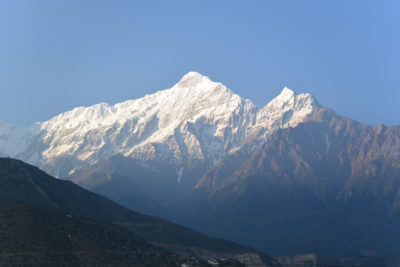Mustang Region, Nepal
Background
The Mustang region of Nepal plays an important role in the history of Indo-Tibetan Buddhism. The Kali Gandaki River runs from China through Upper, Central, and Lower Mustang. This river valley was once a very fertile farming area for barley, potatoes, vegetables, and the famous Pangling apples. Historically, this river valley has served as the main pathway and corridor for the transmission of Bon and Buddhist teachings between India, Tibet, and China. When Shantirakshita, then Padmasambhava, and his 25 disciples, walked from India to Central Tibet to bring Indian Mahayana Buddhism to Tibet at the invitation of the Tibetan king, they walked along the Kala Gandaki River valley. In the eleventh century, the famous Indian Mahayana Buddhist master, Atisha used this same route to bring Buddhist teachings to Tibet. Many cave and hermitage sites still survive in the Kali Gandaki river valley from the days when Padmasambhava and his disciples practiced there. Upper Mustang is also an area steeped in the culture of the cave and hermitage yogis. Most of the important advances and new discoveries in meditation over the years came from this once viable hermitage and cave yogi culture.

The Bon, the indigenous and oldest religion of Tibet, has strong roots in Mustang. Prior to the 8th century nearly all the practitioners, both cave and hermitage yogis and monastics alike, were originally Bon. As Indian Mahayana Buddhism found its way to Tibet, Bon and Nyingma Buddhist practitioners practiced side-by-side collaboratively in the same sacred area. In the 13th and 14th centuries, both groups of practitioners flourished.
The sacred transmissions of Bon and Buddhist rDogs Chen [Great Completion] Meditations have been transmitted from heart-to-heart from one generation to the next in an unbroken lineage as far back as 6,000 to2,500 years ago, depending on the lineage. With the invasion of old Tibet by the communist Chinese in 1959, the continuity of these heretofore uninterrupted lineage transmissions was seriously disrupted. This is why the indigenous Tibetan areas of the Dolpo and Mustang regions of Nepal, and the country of Bhutan, are so important—these areas are the only places where there remains the possibility of an unbroken transmission of these sacred Great Completion Bon and Buddhist lineage transmissions. However, in Mustang, for the last two generations since 1954, the indigenous Tibetan people of Nepal no longer learn to speak their indigenous Tibetan language. None of the Tibetans of this generation can read their own sacred texts in the Tibetan language, nor can they do their familiar prayers and rituals in Tibetan. Recently, when we traveled to Upper Mustang, Nepal, we found only one old Tibetan man who read Tibetan sacred texts. Therefore, we are faced with the very real possibility that all of these precious transmission teachings will die out in the next 10 to 20 years.


